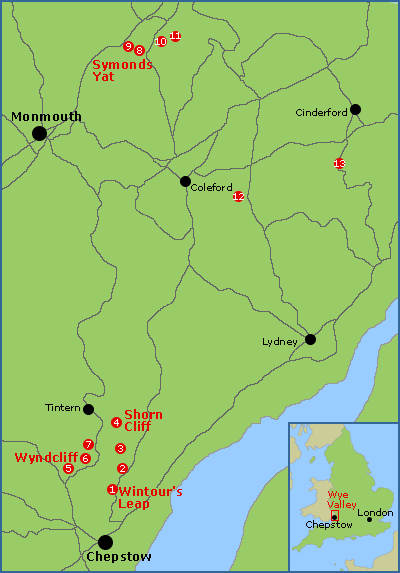Wye Valley Rock Climbing
There is a great variety of rock climbing to be found in the Wye Valley, across a wide range of grades on good quality limestone rock. There is both trad and sport climbing to be found with the main crags being Wyndcliff, Shorn Cliff, Symonds Yat, Ban-y-gor, and Wintour’s Leap. At the top of all of these crags there are great panoramic views across the valley and the River Wye.
Map of the rock climbing areas in the Wye Valley

| 1 | Wintour's Leap | Trad and sport climbing | Limestone |
|---|---|---|---|
| 2 | Ban-y-Gor | Sport climbing | Limestone |
| 3 | Tintern Quarry | Sport climbing | Limestone |
| 4 | Shorn Cliff | Trad climbing | Limestone |
| 5 | Wyndcliffe | Trad climbing | Limestone |
| 6 | Wyndcliffe Quarry | Sport climbing | Limestone |
| 7 | Black Cliff Quarry | Sport climbing | Limestone |
| 8 | Symonds Yat | Trad climbing | Limestone |
| 9 | Doward | Trad and bouldering | Sandstone |
| 10 | Huntsham Crags | Trad and bouldering | Sandstone |
| 11 | Copper Hill | Trad and bouldering | Sandstone |
| 12 | Sion Kop | Trad and bouldering | Sandstone |
| 13 | Ruspidge Quarries | Trad and bouldering | Sandstone |
- Symonds Yat rock climbing guidebook – comprehensively covering the trad at Symonds Yat, plus the sandstone outcrops in the Forest of Dean
- Wye Valley sport climbing guidebook – comprehensively covering the sport climbing at Woodcroft Quarry (Wintour’s Leap), Wyndcliff Quarry, Ban-y-gor, Black Cliff and Tintern Quarry
- Rockfax West Country Climbs – A selective guidebook covering the best trad climbing and sport climbing at Symonds Yat, Wintour’s Leap, Shorn Cliff, Wyndcliff, and Ban-y-gor.
- South West Climbs Volume 1 guidebook – a selective guidebook mainly covering the trad climbing across the whole of the Wye Valley
- Esoteric Bouldering Regions of Bristol guidebook – Covers 13 crags in the Forest of Dean including Huntsham Hill
Trad and sport climbing at Wintour’s Leap
Wintour’s Leap is the largest crag in the Wye Valley with mainly multi-pitch trad routes up to 90m long, though there are single-pitch routes as well. The grade range is vast from good quality 4-pitch VDiff’s to many classic routes up to around E5/E6. The climbing is on superb compact limestone rock with styles ranging from cracks, flakes, technical faces to outrageous overhangs.
Along the main face of Wintour’s Leap there are a few of sport routes though these are mainly in the F7’s. However at the back of the crag is Woodcroft Quarry that has been developed into a sport climbing area with around 50 routes, many of which are in the F4 to F6b grade range.
Though Wintour’s Leap faces west there is extensive tree coverage at the base of the crag and therefore the ideal time to climb at Wintour’s Leap is during the spring and autumn. Sport climbing in Woodcroft Quarry is possible throughout the year as various sectors capture the warmth of any winter sunshine and others are shaded to escape from any summer heat.
Trad climbing at Shorn Cliff
Shorn Cliff offers long single pitch trad routes on unquarried limestone rock, and is one of the most popular crags in the Wye Valley. Shorn Cliff is best known for its slabby wall climbing on highly featured limestone rock that could have been purpose-built for trad climbing. Incut pockets and slots swallow fingers, wires and cams, whilst on steeper walls concretions of all sizes and shapes provide bizarre holds from tiny crimps to absurd jugs. There are also a few excellent crack lines scattered along the cliff. Shorn Cliff is the place for the mid-grade climber with the majority of the routes in the VS to E2 range.
Whilst the base of the crag is tree-shrouded, much of the rock basks in the afternoon sun and it is possible to climb at Shorn Cliff throughout the year, though the best times are in the spring and autumn.
Sport and trad climbing at Wyndcliff
The main Wyndcliff crag offers long single-pitch trad routes in the mid-grade range of HS to E2. The best routes are all sustained, following strong natural lines up grooves and crack with plentiful natural protection.
Wyndcliff Quarry is the largest sport climbing area within the Wye Valley. Here there are over 100 well-bolted sport routes, with the majority in the F4 to F6b+ grade range. Wyndcliff Quarry faces south and is the best place to climb in the Wye Valley from the autumn through to spring. The crag is surprisingly well sheltered and quickly becomes a sun trap at the first hint of sun, and it is the first place in the Wye Valley to be dry after any rain.
Sport climbing at Ban-y-gor
Trad climbing Symonds Yat
The steep limestone buttresses of Symonds Yat are perched high above the River Wye, peeking out of picturesque woodland. Symonds Yat is a popular climbing venue with the added bonus of having the parking and a tea shack at the top of the crag.
The climbing at Symonds Yat is usually on good, steep juggy limestone rock that includes a great variety of rock features, including a free standing pinnacle and caves. The routes are generally between 10m and 30m long, plus some longer 2-pitch routes, across a wide range of grades. Generally the protection is good but can be spaced with the occasional route having a bold start.